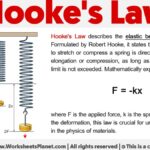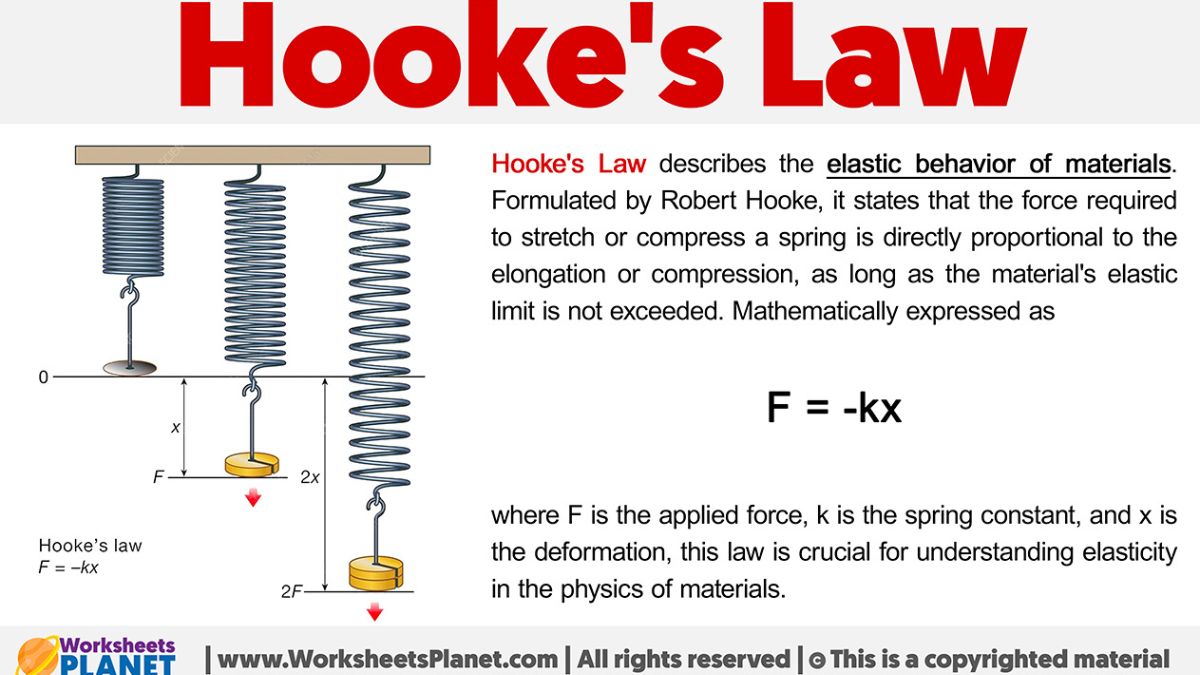Elasticity is everywhere—from trampolines and car suspensions to the stretched rubber band in your hand. To describe how materials behave when forces are applied, scientists rely on a fundamental principle called Hooke’s Law. Whether you’re a student, a curious scientist, or someone looking to refresh high school physics, this guide will break down Law, its applications, and why it matters.
What is Hooke’s Law?
Named after 17th-century British physicist Robert Hooke, this law explains the relationship between the force applied to a spring (or other elastic objects) and the resulting deformation. Simply put, Hooke’s Law states that the extension or compression of an elastic object is directly proportional to the force applied to it, as long as the material stays within its elastic limit.
The Formula for Hooke’s Law
The mathematical expression for Hooke’s Law is:
- F is the force applied (measured in Newtons, N)
- k is the spring constant (specific to the material, measured in N/m)
- x is the displacement or change in length (measured in meters, m)
The negative sign in the equation indicates that the force is restoring—it acts in the opposite direction of displacement to bring the object back to equilibrium.
Breaking Down the Elastic Limit
Hooke’s Law applies only while the material remains within its elastic limit—a point beyond which the material no longer returns to its original shape when the force is removed. Think of a spring that’s stretched too far and becomes permanently deformed. That’s when Law ceases to work.
How Hooke’s Law Works in Real Life
Hooke’s Law sounds abstract, but it’s incredibly relevant. When you pull, push, or stretch, Hooke’s Law is often at play. Here are a few practical examples to consider:
Springs in Everyday Mechanics
Springs are the poster child for Hooke’s Law. Whether it’s the suspension in a car or the spring in a mechanical pen, these devices rely on predictable elastic behavior. For instance, a lightweight spring in a ballpoint pen hardly needs force to compress, while the suspension springs in a truck require much greater force for minimal compression due to a higher spring constant (k).
Elastic Bands
Stretching a rubber band? The farther you pull (force applied), the longer the band gets (displacement). Stop the stretching within its limits, and it snaps back to its original form. Stretch it too far, though, and it loses its bounce-back ability.
Measuring Forces in Labs
Physicists regularly use Hooke’s Law for precise force measurement. Devices such as spring scales and force meters utilize springs calibrated with Law to determine the weights of objects.
Musical Instruments
Stringed instruments like guitars and violins also function on elastic principles. Tuning involves adjusting string tension (force), which impacts how far the string vibrates and ultimately affects the pitch.
Why Hooke’s Law Matters
At first glance, Hooke’s Law seems like a simple concept. But its implications touch upon crucial fields of science and engineering.
Structural Engineering
Every building, bridge, and airplane relies on knowledge about how materials behave under stress. Engineers test materials for elasticity to ensure that they won’t buckle or crack under typical loads.
Medical Science
Sticking a needle into flesh, designing prosthetics, or even measuring blood vessel elasticity relies on Law principles. By understanding the elastic properties of organic and artificial materials, life-saving medical devices can be developed and refined.
Sports Equipment Design
Squash rackets, running shoes, trampolines—athletes need elasticity for performance. Law governs the behavior of the springs, rubber, and other materials used in these products to provide a balance of flexibility, force absorption, and durability.
Seismology
Shock-absorbing buildings in earthquake-prone regions incorporate principles derived from elasticity, which are deeply rooted in Law. These designs absorb vibrations while minimizing deformation and damage to structures.
Applications Beyond the Elastic Limit
While Hooke’s Law describes linear elasticity, real-world materials don’t always behave “perfectly” when force is applied. Once a material surpasses its elastic limit, it may decompose into other types of deformation:
1. Plastic Deformation
After exceeding the elastic limit, materials undergo permanent deformation. For instance, bend a paperclip, and it won’t snap back into shape.
2. Fracture or Breakage
Exceed the ultimate strength of a material, and it fractures. Think of a rubber band that snaps when you pull too hard.
These phenomena often require extensions of Hooke’s Law, combining nonlinear curves and stress-strain analyses to describe the behavior of various materials accurately.
How to Experiment with Hooke’s Law
If you want to explore Hooke’s Law at home or in a classroom, here’s a simple experiment to try.
Materials Needed:
- A spring
- A set of weights
- A ruler
- A clamp stand
Steps:
- Attach one end of the spring to a clamp stand.
- Measure the spring’s initial length using the ruler (in meters).
- Add a weight to the free end of the spring and note the extension (difference between the stretched length and initial length).
- Repeat this process with additional weights, noting both force (weight) and extension each time.
Analyzing Data:
Create a graph plotting force (F) on the y-axis and displacement (x) on the x-axis. If the spring operates within its elastic limit, the graph will produce a straight line. The slope of the line is k, the spring constant!
Elastic Thinking for a Creative World
Hooke’s Law may seem rooted in physics, but its essence—how small forces lead to big impacts within limits—is a metaphor for innovation. Materials, and even people, thrive when stretched to their optimum capacity—so long as those limits are mindfully respected!
Start thinking about elasticity the next time you encounter a spring, rubber band, or even trampoline. You’ve got Hooke’s Law to thank for these everyday marvels.
FAQs
What is Hooke’s Law?
Hooke’s Law states that the force exerted by a spring is directly proportional to its displacement, as long as the material remains within its elastic limit. Mathematically, this is expressed as F = -kx, where F is the force, k is the spring constant, and x is the displacement.
How does elasticity relate to creativity?
Elasticity, as a metaphor, highlights the power of adaptability and resilience. Just as materials perform best when stretched within their optimal range, people can achieve creative breakthroughs when they challenge themselves without exceeding their limits.
Where can I see examples of Hooke’s Law in daily life?
Some common examples include springs in mechanical devices, rubber bands, trampolines, and even the cushioning of mattresses. Each of these utilizes elasticity to provide functionality and comfort.
What happens when a material exceeds its elastic limit?
When a material is stretched beyond its elastic limit, it deforms permanently and can no longer return to its original shape. This signifies a breakdown in elasticity and highlights the importance of respecting physical limits.





